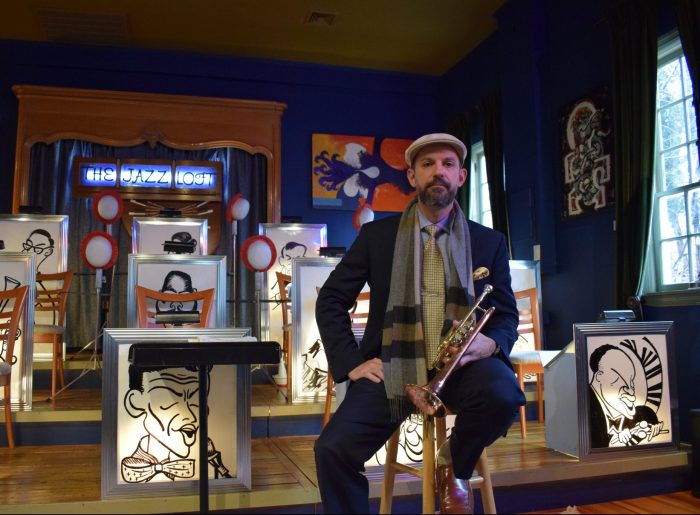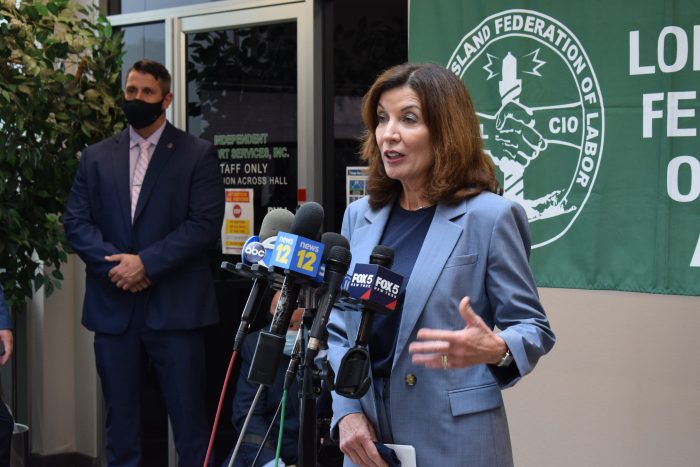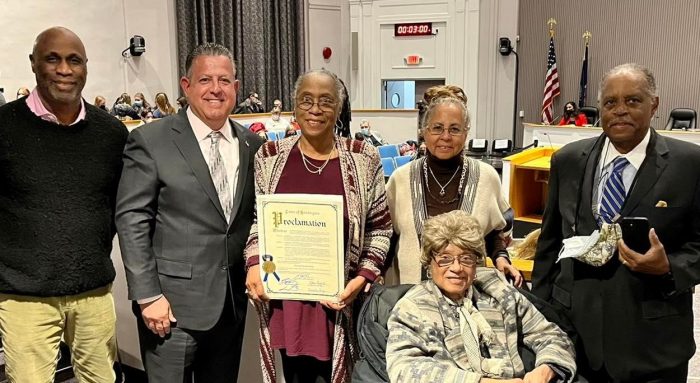Discussions have dragged on and on, and even as years turned to decades the dream of an electrified northern line of the Long Island Rail Road has shuddered along, like a train limping forward on little to no steam.
Though local leaders now say the time is ripe. With state reps championing the cause in Albany, local leaders are holding up a plum location for the necessary rail yard: Lawrence Aviation.

The 126-acre superfund site in Port Jefferson Station has sat vacant since 2000, after the airplane parts company was accused of leaching chemicals into the ground. Ground cleanup was completed in 2009, and asbestos was removed from some of the buildings in 2015, according to the U.S. Environmental Protection Agency.
Various sources confirmed that late last year, local civic leaders as well as representatives from Brookhaven, Smithtown and Huntington townships, joined Suffolk County and state leaders on the superfund site property to identify where such a rail yard could be built. The latest update on the property by the EPA, dated October 2021, stated that the site consists of 10 buildings, a drum crushing site, and a vacant lagoon and woods.
Yet officials across both parties have long supported the project, which has been talked about for over four decades. It’s a project the environmental and economics-minded people have been on board with. Both previous state Sens. Ken LaValle (R-Port Jefferson) and John Flanagan (R-East Northport) were proponents, and many electeds like Brookhaven Town Supervisor Ed Romaine (R) have long called on the Metropolitan Transportation Authority to move the project forward.
What’s different now? Charlie Lefkowitz, president of Three Village Chamber of Commerce, said the most recent change in state leadership has resulted in a “newfound focus” on electrification. He agreed that Lawrence Aviation, which is tucked far enough away from residential houses to be not detrimental to homeowners, would be an optimal place for a yard.
The chamber leader also cited how much of a beneficial impact electrifying the line would have on the surrounding economy, especially with how Stony Brook students can use the train to traverse to hotspots like Port Jefferson or Huntington villages.
“Creating viable, sustainable public transportation really has to be looked at hard here,” Lefkowitz said.
In a written statement, state Sen. Anthony Palumbo (R-New Suffolk) further put his support behind the project.
“There is broad and bipartisan support to turn the site into a new rail yard to provide greater service to the region,” he wrote. “It is also a crucial component in the plan to electrify the Port Jefferson line. With the state and federal government investing billions of dollars in infrastructure there is no excuse not to get these projects completed now.”
“Creating viable, sustainable public transportation really has to be looked at hard here.”
— Charlie Lefkowitz
Suffolk County officials said they have had this property in mind for civic development since at least 2015. Deputy County Executive Peter Scully, known as the county’s water quality czar, said that there’s a current $860,000 annual cost to taxpayers due to a number of liens on the property, and the federal government is also looking to make up costs on the $150 million cleanup.
The county has already received legislative approval to settle with all the lien claimants, and execution on those settlements will likely happen in the next six to eight weeks, according to the deputy county executive.
“We have developed a cooperative working relationship with the state and federal governments to process those liens,” Scully said during a Zoom interview.
The Suffolk County Landbank put out a request for proposal in July of last year for companies to develop the Lawrence Aviation site. Early concepts of the site detail a portion of the property zoned for light industrial, while another section on the eastern end will be preserved as open space. Notably, the north end of the property conceptualizes an MTA railyard. The study also mentions potential plans to reroute the train tracks and potentially moving the Port Jefferson train station onto the Lawrence Aviation site as well, which would eliminate the crossing on Route 112.
Sarah Lansdale, president of the landbank and the county’s planning and environment director, said that and other concepts are on the table.
She confirmed the county received one bid back on the RFP for a solar farm on the industrial part of the property, though she did not offer further details as negotiations are ongoing.
Waiting on the MTA
With those claims out of the way, all that’s left is for the MTA to make a decision regarding electrification, but the transportation entity has been notoriously tight-lipped regarding this and other projects. The MTA included $4 million in their five-year 2015-19 capital plan to pay for a feasibility study on electrification of the Port Jefferson Branch, and while the transportation entity confirmed the study is in motion, there is no word on when it will be completed.
Dave Steckel, a spokesperson for the MTA, said in a statement that a feasibility study is one “among a variety of transit proposals throughout the region” and that “the authority will assess the study and other regional proposals using consistent metrics — such as cost, ridership, etc. — so that they can be comparatively evaluated.”
The analysis will also be used in MTA’s 20-year needs assessment, which is due next year.
That’s not to say the project is unknown to transportation officials. Kevin Law, past president of the Long Island Association who just recently stepped down from the MTA board, offered his support to two Island-based projects, according to Newsday. One was to finish the Yaphank station and the other to finish Port Jeff line electrification. Law is moving on to be the new director of Empire State Development.
Anthony Figliola, a civic leader in the Three Village area who is running for the New York District 1 congressional seat on the Republican ticket, said that he has talked to railroad officials who have confirmed the feasibility study is ongoing, though he and other civic leaders have not seen it yet. He added he’s spoken to the NYS Senate transportation committee leader, and that the local state electeds are on board.
“We’re on the radar as far as Albany is concerned,” Figliola said. “These are big capital projects that take a lot of time and planning. So while you know, while it may not happen right now, we need to start planning for this for the future, because COVID will be over, and life will get back to normal.”
Some transportation advocates say the silence is a bad sign. Larry Penner, a self-described transportation historian and writer from Great Neck, spent 31 years in the U.S. Federal Transit Administration Region 2 New York Office. In a phone interview, he said riders should not expect anything on electrification until 2034, at least.
“We’re on the radar as far as Albany is concerned.”
— Anthony Figliol
He pointed to the Feb. 8 public hearing from the MTA which did not include mention of Port Jeff electrification. He also mentioned that there’s no money for the project in the MTA’s 2020-24 five-year capital plan. After the feasibility study is released, the MTA will then need to do the EPA’s environmental review process, which will allow for further FTA funding. The same amount of lead up time to acquiring a rail yard is likely to be the same.
“It’s a package deal,” Penner said. “You can’t build a storage without electrification and Federal Transit Administration funding. With this requirement that you fund a transportation improvement project, it has to go to beneficial use. So you couldn’t build a yard and have it sit there for 15 years.”
Scully said they have been in communication with MTA board members, but emphasized that timing is important for the MTA to start making moves on both electrification and Lawrence Aviation. Lansdale said the county is tasked with disposing all parts of the property, and without an agreement they may have to move on.
But another piece of the puzzle remains whether riders will return to the LIRR, especially as the pandemic continues. Many workers have realized the benefits of working from home, and many city offices remain in remote work. Though it had increased marginally in October of last year, weekday ridership on the LIRR continues to be about 50% of what it was in 2019, before the pandemic.
Penner said that problem likely overshadows any attempt to add more services on existing lines. The existing MTA projects like the ongoing $11.2 billion East Side Access to Grand Central Station promised tens of thousands of new riders when originally proposed, but with the ongoing pandemic he remains skeptical. “You want to protect and maintain the existing service before you expand service,” the transportation historian said.
Still, locals like Lefkowitz and Figliola remain optimistic about ridership bouncing back.
“As a New Yorker who lived through tragedies like 9/11 and others, I think there will be people going back from the trains,” Lefkowitz said. “I do believe that at some point, these things will get back to whatever the next transition of our future is, but I believe people will be riding the trains.”


































































































